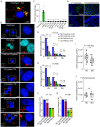Malnutrition and maternal vaccination against typhoid toxin
- PMID: 35960787
- PMCID: PMC9401117
- DOI: 10.1371/journal.ppat.1010731
Malnutrition and maternal vaccination against typhoid toxin
Abstract
Children are particularly susceptible to typhoid fever caused by the bacterial pathogen Salmonella Typhi. Typhoid fever is prevalent in developing countries where diets can be less well-balanced. Here, using a murine model, we investigated the role of the macronutrient composition of the diet in maternal vaccination efficacies of two subunit vaccines targeting typhoid toxin: ToxoidVac and PltBVac. We found that maternal vaccinations protected all offspring against a lethal-dose typhoid toxin challenge in a balanced, normal diet (ND) condition, but the declined protection in a malnourished diet (MD) condition was observed in the PltBVac group. Despite the comparable antibody titers in both MD and ND mothers, MD offspring had a significantly lower level of typhoid toxin neutralizing antibodies than their ND counterparts. We observed a lower expression of the neonatal Fc receptor on the yolk sac of MD mothers than in ND mothers, agreeing with the observed lower antibody titers in MD offspring. Protein supplementation to MD diets, but not fat supplementation, increased FcRn expression and protected all MD offspring from the toxin challenge. Similarly, providing additional typhoid toxin-neutralizing antibodies to MD offspring was sufficient to protect all MD offspring from the toxin challenge. These results emphasize the significance of balanced/normal diets for a more effective maternal vaccination transfer to their offspring.
Conflict of interest statement
The authors have declared that no competing interests exist.
Figures







Similar articles
-
In vivo tropism of Salmonella Typhi toxin to cells expressing a multiantennal glycan receptor.Nat Microbiol. 2018 Feb;3(2):155-163. doi: 10.1038/s41564-017-0076-4. Epub 2017 Dec 4. Nat Microbiol. 2018. PMID: 29203881 Free PMC article.
-
Prophylactic potential of cytolethal distending toxin B (CdtB) subunit of typhoid toxin against Typhoid fever.Sci Rep. 2019 Dec 5;9(1):18404. doi: 10.1038/s41598-019-54690-1. Sci Rep. 2019. PMID: 31804525 Free PMC article.
-
IgA and IgG1 Specific to Vi Polysaccharide of Salmonella Typhi Correlate With Protection Status in a Typhoid Fever Controlled Human Infection Model.Front Immunol. 2019 Nov 1;10:2582. doi: 10.3389/fimmu.2019.02582. eCollection 2019. Front Immunol. 2019. PMID: 31781100 Free PMC article. Clinical Trial.
-
Review of current typhoid fever vaccines, cross-protection against paratyphoid fever, and the European guidelines.Expert Rev Vaccines. 2017 Oct;16(10):1029-1043. doi: 10.1080/14760584.2017.1374861. Expert Rev Vaccines. 2017. PMID: 28856924 Review.
-
Review on the Recent Advances on Typhoid Vaccine Development and Challenges Ahead.Clin Infect Dis. 2020 Jul 29;71(Suppl 2):S141-S150. doi: 10.1093/cid/ciaa504. Clin Infect Dis. 2020. PMID: 32725225 Free PMC article. Review.
Cited by
-
Rifampin mediated decapsulation and enhanced bacterial clearance: a new mechanism of rifamycins.EBioMedicine. 2025 Jul;117:105787. doi: 10.1016/j.ebiom.2025.105787. Epub 2025 Jun 4. EBioMedicine. 2025. PMID: 40466437 Free PMC article.
-
Bacterial AB toxins and host-microbe interactions.Adv Microb Physiol. 2022;81:67-109. doi: 10.1016/bs.ampbs.2022.06.002. Epub 2022 Jul 18. Adv Microb Physiol. 2022. PMID: 36167443 Free PMC article. Review.
-
Antimicrobial properties of tomato juice and peptides against typhoidal Salmonella.Microbiol Spectr. 2024 Mar 5;12(3):e0310223. doi: 10.1128/spectrum.03102-23. Epub 2024 Jan 30. Microbiol Spectr. 2024. PMID: 38289090 Free PMC article.
-
Molecular basis of the hepatobiliary tropism of typhoid toxin promoting Salmonella pathogenicity.Sci Adv. 2025 Jun 6;11(23):eadt2040. doi: 10.1126/sciadv.adt2040. Epub 2025 Jun 6. Sci Adv. 2025. PMID: 40479051 Free PMC article.
-
Single missense mutations in Vi capsule synthesis genes confer hypervirulence to Salmonella Typhi.Nat Commun. 2024 Jun 19;15(1):5258. doi: 10.1038/s41467-024-49590-6. Nat Commun. 2024. PMID: 38898034 Free PMC article.
References
-
- Klemm EJ, Shakoor S, Page AJ, Qamar FN, Judge K, Saeed DK, et al.. Emergence of an Extensively Drug-Resistant Salmonella enterica Serovar Typhi Clone Harboring a Promiscuous Plasmid Encoding Resistance to Fluoroquinolones and Third-Generation Cephalosporins. MBio. 2018;9(1):e00105–18. doi: 10.1128/mBio.00105-18 . - DOI - PMC - PubMed
-
- Kim C, Latif I, Neupane DP, Lee GY, Kwon RS, Batool A, et al.. The molecular basis of extensively drug-resistant Salmonella Typhi isolates from pediatric septicemia patients. PLoS One. 2021;16(9):e0257744. Epub 2021/09/29. doi: 10.1371/journal.pone.0257744 ; PubMed Central PMCID: PMC8478237. - DOI - PMC - PubMed
Publication types
MeSH terms
Substances
Grants and funding
LinkOut - more resources
Full Text Sources
Medical
Molecular Biology Databases

